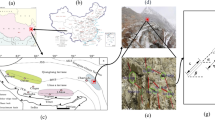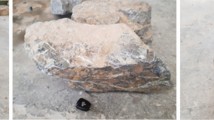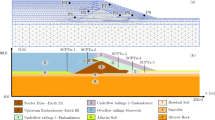Abstract
In the last decades, accidents involving dams and other hydraulic structures have become more frequent, increasing social pressure on the existing dams safety conditions. This fact demands commitment of professionals and companies with new plant project safety approaches. The failure of a hydroelectric concrete structure can be caused by several factors, however the main causes of failure are related to exceptional floods and foundation-related problems, which are the focus of this paper. In order to understand the influence of the rock mass characteristics, especially the contact plan with the concrete structure, this work considers the variability of geotechnical parameters, drainage efficiency, specific gravities and seismic acceleration to determine the probability of failure of these structures. To achieve this objective, the work makes use of a case study, the spillway of Baixo Iguaçu HPP, on Paraná/Brazil during its design and construction phase, determining the probability of failure by sliding. The study reproduces the foundation condition throughout a FEM hydrogeological model and determines the acting uplift through seepage analysis. The probability of failure was determined by Monte Carlo method using the probability distribution of each variable, performing 5,000,000 evaluations for each simulation. Simulations were performed for flow range varying from the ecological flow (200 m3/s) to exceptional floods with 10,000 years of recurrence time (56,362 m3/s) and its respective water levels. The most critical condition found was the extended operation at the minimum (ecological) flow, while for a normal operation, at the flow of 2598 m3/s, the order of the probability of failure is one in a million. The paper show how using hydrogeological model can lead to more realistic values of uplift pressures than using simplified methods recommended in the international guidelines, and consequently lead to a more realistic probability of failure.









Similar content being viewed by others

References
ABNT—Associação Brasileira de Normas Técnicas (2006) NBR 15421:2006—Projeto de Estruturas Resistentes a Sismos—Procedimento. Rio de Janeiro, Brazil.
Andrade RMA (1982) Drenagem nas Fundações das Estruturas Hidráulicas—Análise, Interpretação, Prática. Centro de Documentação do Dept. de Engenharia Civil da Engevix S.A. Rio de Janeiro, Brazil.
Eletrobrás (2003) Critérios de Projeto Civil de Usinas Hidrelétricas. Rio de Janeiro, Brazil.
EPRI—Electric Power Research Institute (1992) Uplift pressures, shear strengths, and tensile strengths for stability analysis of concrete gravity dams. Volume 1. Final Report. Stone and Webster Engineering Corp. Denver
García LA, Bueno IE, Lombillo AS, Ortuño MGM (2012) Methodology for estimating the probability of failure by sliding in concrete gravity dams in the context of risk analysis. Struct Saf 36–37:1–13
Geo-Slope International Ltd (2012) Seepage modeling with seep/W 2012 an engineering methodology. Geo-Slope International Ltd., Calgary
Hoek E, Caranza-Torres C, Corcum B (2002) Hoek–Brown failure criterion—2002 edition. In: Mining innovation and technology, Toronto, pp 267–273
ICOLD—International Commission on Large Dams (2005) Risk Assessment in Dam Safety Management. Bulletin 130
IQBAL A (2012) Probability of failure for concrete gravity dams for sliding failure. In: Proposal to solution for the eleventh ICOLD Benchmark Workshop, Master of Science Thesis, Stockholm, Sweden
Krüger CM (2008) Análise de Confiabilidade Estrutural Aplicada as barragens de concreto. Doctorate Theses—PPGMNE, Universidade Federal do Paraná, Curitiba
Melchers RE (1999) Structural reliability analysis and prediction, 2nd edn. Wiley, Newcastle
ORACLE Crystal Ball (2012) https://www.oracle.com/br/applications/crystalball. Accessed July 2016
Rocscience (2002) RocLab Version 1.0—Rock mass strength analysis using the generalized Hoek–Brown failure criterion. Toronto, Ontario, Canada
Ruggeri G (2004) Sliding stability of existing gravity dams—Final report. ICOLD European Club
U. S. Army Corps of Engineers (1995) EM 1110-2-2200: engineering and design—gravity dams, Washington, DC
U. S. Army Corps of Engineers (1999) ETL - 1110-2-556, Risk-based analysis in geotechnical engineering for support of planning studies, Washington, DC
U. S. Bureau of Reclamation (1976) Design of gravity dams, Denver
Vieira VPPB (2005) Análise de Risco em Recursos Hídricos: Fundamentos e Aplicação, 1st edn. ABRH, Nashville
Westberg M (2007) Reliability-based evaluation of concrete dams. Licentiate Thesis. Lund, Sweden
Westergaard HM (1933) Water pressures on dams during earthquakes. Trans ASCE 98:434–436
Author information
Authors and Affiliations
Corresponding author
Additional information
Publisher's Note
Springer Nature remains neutral with regard to jurisdictional claims in published maps and institutional affiliations.
Rights and permissions
About this article
Cite this article
Almeida Souza, L.R., Marques Filho, J. Application of Probabilistic Method to Evaluate the Rock Mass Foundation Influence over the Probability of Failure by Sliding of Hydraulics Structures: Case Study of Baixo Iguaçu HPP Spillway. Geotech Geol Eng 38, 47–60 (2020). https://doi.org/10.1007/s10706-019-00997-9
Received:
Accepted:
Published:
Issue Date:
DOI: https://doi.org/10.1007/s10706-019-00997-9



